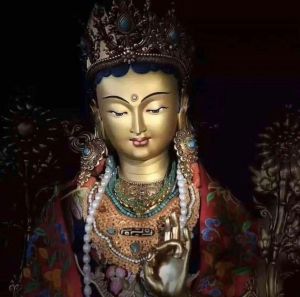Difference between revisions of "The Relation between Buddhist and Hindu Tantra"
(Created page with " Tantra literature began to appear in both the Buddhist and Hindu traditions of India in approximately the third century CE. Precise dates, however, are unavailable and t...") |
|||
| Line 1: | Line 1: | ||
| + | [[File:8504307 n.jpg|thumb]] | ||
| + | |||
| + | [[Tantra]] {{Wiki|literature}} began to appear in both the [[Buddhist]] and [[Hindu]] [[traditions]] of [[India]] in approximately the third century CE. Precise dates, however, are unavailable and the two [[traditions]] undoubtedly predated the [[appearance]] of their texts. Although the [[philosophical]] and [[ethical]] contexts differ, nevertheless devotional practices, [[yoga]] exercises, and numerous aspects of earlier {{Wiki|matriarchal}}, tribal, and [[outcaste]] customs are prominent in each. For example, | ||
| − | + | both systems include [[visualization]] of multiarmed, multifaced figures, manipulation of [[subtle energies]] through energy-nodes (Skt. [[chakras]]), veneration of women, use of [[bone ornaments]] and musical instruments, [[imagery]] from [[cremation grounds]] and slaughterhouses, and [[transformation]] of unclean [[bodily]] products. Thus, it is difficult to prove that one was the source of a specific feature in the other. One can merely say that the two were contemporaneous movements. Moreover, since [[Buddhist]] and [[Hindu tantra]] practitioners often frequented the same [[sacred places]], each group probably influenced the other. | |
| − | |||
| − | |||
| − | |||
| − | |||
| − | + | [[Buddhologists]] and [[traditional]] [[Tantrayana]] [[scholars]] agree that the [[history of Buddhism]] chronicles the [[adaptation]] of basic [[Buddhist]] themes to varying {{Wiki|cultural}} milieus, but they differ in their explanations of the process. [[Buddhologists]] do not accept that [[Buddha]] [[taught]] the [[tantras]]. They posit that later [[masters]] developed a [[tantra]] [[form]] of [[Buddhism]] and composed its texts to accord with the [[spirit]] of the times in [[India]]. [[Traditional]] [[Tantrayana]] [[scholars]], on the other hand, assert that [[Buddha's]] [[supramundane]] [[powers]] enabled him to foresee {{Wiki|cultural}} | |
| − | |||
| − | and | ||
| − | |||
| − | of | ||
| − | |||
| − | |||
| − | + | developments and that he personally [[taught]] [[tantra]] to suit [[people]] of the {{Wiki|future}}. Thus, "when the times were ripe," those who secretly transmitted the [[tantras]] - orally or [[Wikipedia:burial|buried]] in their [[mental]] continuums - made them available to receptive practitioners. Alternatively, [[Buddha]] revealed the [[tantras]] in [[pure visions]] to the highly accomplished [[masters]] who first recorded them. The explication of each [[scholarly]] group accords with its particular view of [[Buddha]] and the general [[Buddhist]] [[principle]] of [[teaching]] with [[skillful means]]. | |
| − | |||
| − | in their | ||
| − | tantras. | ||
| − | |||
| − | |||
| − | + | {{R}} | |
| − | + | [[Category:Buddhist Terms]] | |
| − | + | [[Category:Buddhism]] | |
| − | + | [[Category:Tibetan Buddhism]] | |
| − | + | [[Category:Vajrayana]] | |
| − | + | [[Category:Tantras]] | |
Latest revision as of 03:16, 30 September 2021
Tantra literature began to appear in both the Buddhist and Hindu traditions of India in approximately the third century CE. Precise dates, however, are unavailable and the two traditions undoubtedly predated the appearance of their texts. Although the philosophical and ethical contexts differ, nevertheless devotional practices, yoga exercises, and numerous aspects of earlier matriarchal, tribal, and outcaste customs are prominent in each. For example,
both systems include visualization of multiarmed, multifaced figures, manipulation of subtle energies through energy-nodes (Skt. chakras), veneration of women, use of bone ornaments and musical instruments, imagery from cremation grounds and slaughterhouses, and transformation of unclean bodily products. Thus, it is difficult to prove that one was the source of a specific feature in the other. One can merely say that the two were contemporaneous movements. Moreover, since Buddhist and Hindu tantra practitioners often frequented the same sacred places, each group probably influenced the other.
Buddhologists and traditional Tantrayana scholars agree that the history of Buddhism chronicles the adaptation of basic Buddhist themes to varying cultural milieus, but they differ in their explanations of the process. Buddhologists do not accept that Buddha taught the tantras. They posit that later masters developed a tantra form of Buddhism and composed its texts to accord with the spirit of the times in India. Traditional Tantrayana scholars, on the other hand, assert that Buddha's supramundane powers enabled him to foresee cultural
developments and that he personally taught tantra to suit people of the future. Thus, "when the times were ripe," those who secretly transmitted the tantras - orally or buried in their mental continuums - made them available to receptive practitioners. Alternatively, Buddha revealed the tantras in pure visions to the highly accomplished masters who first recorded them. The explication of each scholarly group accords with its particular view of Buddha and the general Buddhist principle of teaching with skillful means.
